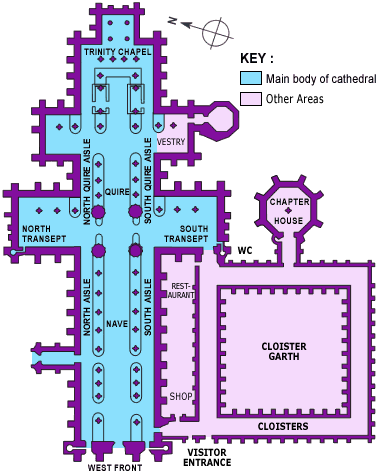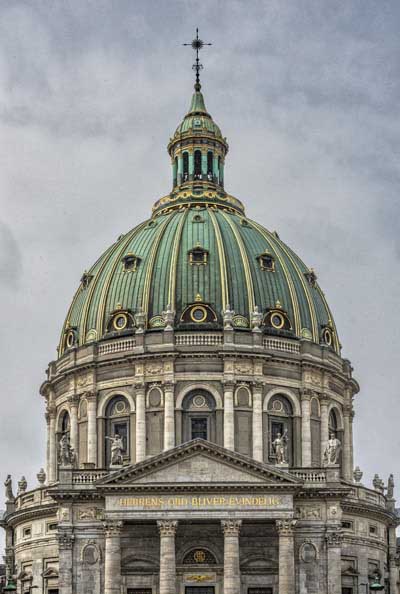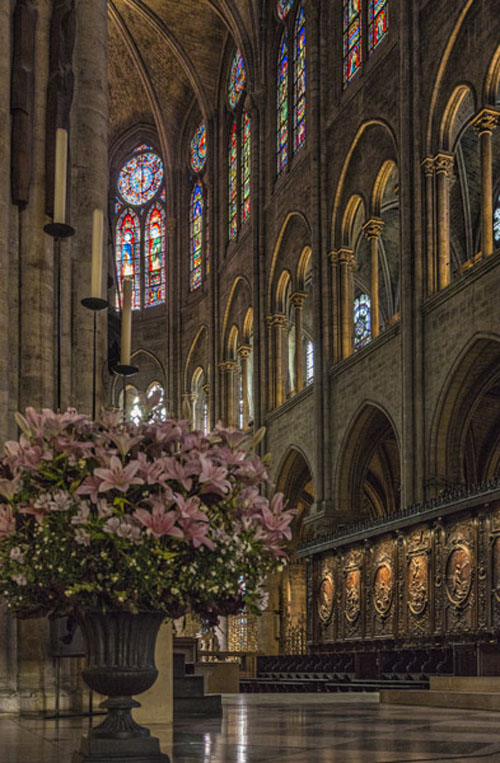Interior
Most cathedrals have a common layout that include a nave, quire, transepts and often a vestry, chaples, cloister, library or a chapter house, a typical of plan is shown below:

When you enter the entrance door often you will walk into the nave, which is the largest open room in the cathedral and is the common area where large gatherings of people can meet. This is an area lined with columns and large glass windows and is covered by a high vaulted ceiling. This is the "awesome room" where you should sit for a few moments and experience your environment. Strong images can be taken of the screen from this area that often separates the nave from the quire.

The quire is where the choir can sit and is an area often used during services. The quire separates the nave from the sanctuary where the alter is located. This area is often entered after passing under the tower which often has the grandest upward views. The quire area is often decorated with ornate wood panels and carvings and is the area where the wonderful organs are usually located. The quire area is usually quite dark but full of wonderful detail and colour. This is another good place to sit and just look and feel.

The sanctuary or alter area is usually a focal point in the cathedral and one of the best places to capture the essence of the place either towards the altar or towards the quire. It is also the most vistied place in the building so if you want to take images you will need to be patience. Usually this area will have a splendid ceiling worth some attention.

The transepts and chapels are areas of high ceilings and wonderful glass windows and are also places where there are many monuments. The cloisters and chapter houses are outside of the main building and can be also ornate and packed with historical monuments.
Ceilings, Domes and Spires
The ceilings are often one of the key features of a cathedral or a large church. Some how the modern home has inherited boring ceilings that are more often than not flat and neutral, but not so in these grand buildings. Looking upward is one of the great pleasures of these buildings that are works of art. The ceiling is where symmetry and form come together and are maximized at a dome or bell tower. However, physically we can not sustain these views for long (unless you lay on the floor), but a photographic image can be taken and allow you the time to study and breath in the image. If you enjoy beautiful painted ceilings you will need to go to Rome and visit some of its amazing 900 churches. You will find ceilings constructed of stone covered plaster and wood many painted with geometric patterns or stunning paintings. Powerful images can be captured if you take advantage of geometrical symmetry. One challenge that will come up is that the ceilings are often lit with windows or are fixed with spotlights this means contrast control will come into play as you can read about on the next page.

Windows
Cathedrals are all about light, with out the windows you would be in a large beautiful cave waiting for a spot light to reveal the work of the historic craftsmen. Stained glass windows from floor to ceiling are only seen in cathedrals and they abound in detail and are a full subject of their own. Windows come in almost any shape you can imagine and are always built into the shape of the structure, great images can be taken straight on or at angles from above or below. Again, careful exposure control is needed to maximize detail, if you slightly underexpose you can gather more detail from the windows, but of course the windows are the source of the light so they need to be luminescent as well.

Flowers
After you visit a few cathedrals you will soon notice that flowers are big part the life of an active cathedral. Fresh flowers are usually refreshed or trimmed on Fridays or Saturdays so these are the best days to take images of fresh flowers.

Figures and Details
Statues and figures are a common opportunity in most cathedrals. Many have beautiful monuments of dedication or images symbolizing a person or an event. Many of the sculptures are world renowned and one can spend many moments looking and reliving the lives represented. As you can tell, I seem to like using monochrome for these types of images. Detail carvings and other objects abound in a cathedral. If you like this sort of thing you will need several visits to these grand structures to see them all and appreciate them.

External
Although I find the interiors fascinating, the external features of cathedrals are also worth spending time studying. It is usually the church spire that is the most recognized part of a town or cities skyline and finding the best viewpoint can take some time. Make sure you look at other people's images of the area before hand so you can plan some viewpoints. If possible take time to take the “tower” tour that are offered at most cathedrals, here you will be able to see the cathedral from higher up and likely walk on the roof for even better views of the cathedral and surrounding area. Also, make sure you spend the time to walk entirely around the cathedral or large church. Many of these buildings are now surrounded tightly by newer structures so careful viewing down alleys and small street is often necessary to view the buildings from a distance. Nighttime images can be rewarding so make sure you go and look again after dark.



